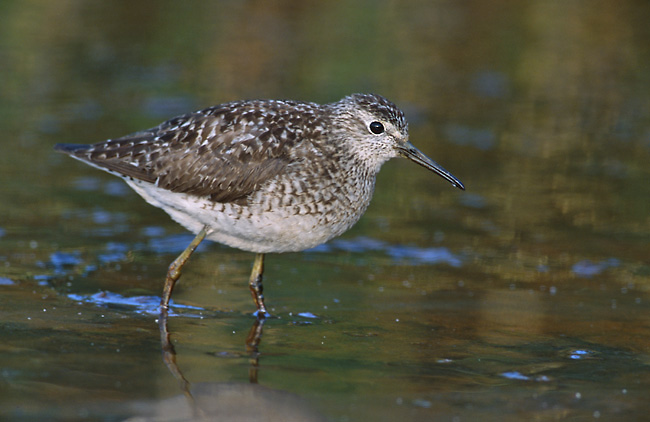
which shows up the barring that extends from the lower breast into the flanks, and the extent of white marking on the back. Note that this rather nice photo is not one of mine .

Wood Sandpiper, Prime Hook NWR - 5/11/2008
Images and text copyright © Phil Jeffrey 2008
Sharon Lynn amazing found a strange looking sandpiper at Broadkill Beach Impoundment in Prime Hook National Wildlife Refuge in Delaware on May 5th 2008. By May 7th it had been confirmed as a Wood Sandpiper and was cooperative enough to hang around for at least a week.
Wood Sandpiper nests in northern Europe and Asia and winters in Africa and southern Asia. It has a preference for fresh water. In the US it's found mostly in the Aleutians. In the rest of the USA there as a record in 1907 and one in 1990 from Marshlands Conservancy in Rye, NY.
You can peruse the wikipedia entry for Wood Sandpiper here. It bears a superficial resemblance to Solitary Sandpiper but the upperparts are much more strongly marked as are the neck and flanks. The flight style is somewhat similar but the Wood Sandpiper has a white rump. In Britain, where I've seen a fair number of these birds, the most similar species is Common Redshank and Green Sandpiper. There's some resemblance to Lesser Yellowlegs - especially in breeding plumage - but the larger latter is longer-legged, which should also be evident in flight. The Wood Sandpiper has a fairly prominent supercilium that extends behind the eye which also gives it the appearance of a dark cap - this is absent on the Yellowlegs and with Solitary Sandpiper too. The Yellowlegs and Common Redshank have typical emphatic scolding calls, but the Wood Sandpiper's is closer in quality to that of the Common Sandpiper and Solitary Sandpiper. Although I did not hear this particular Wood Sandpiper vocalize, even when it flew right over my head.
This image link illustrates breeding plumage pretty well.
Or you can google image search for more. I've in-lined this WikiMedia Commons image from Marek Szczepanek:

which shows up the barring that extends from the lower breast into the flanks, and the extent of white marking
on the back. Note that this rather nice photo is not one of mine .
Anyway, here are four photos of the Wood Sandpiper from Delaware. They were
taken in flat light with stacked tele-extenders so they are predictably
mediocre:
|
|
|
|
|
|
|
|